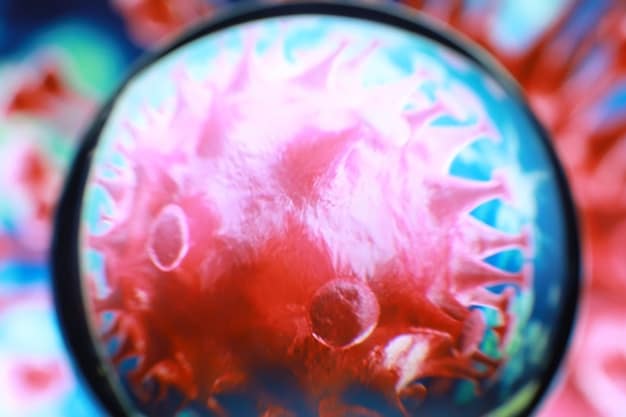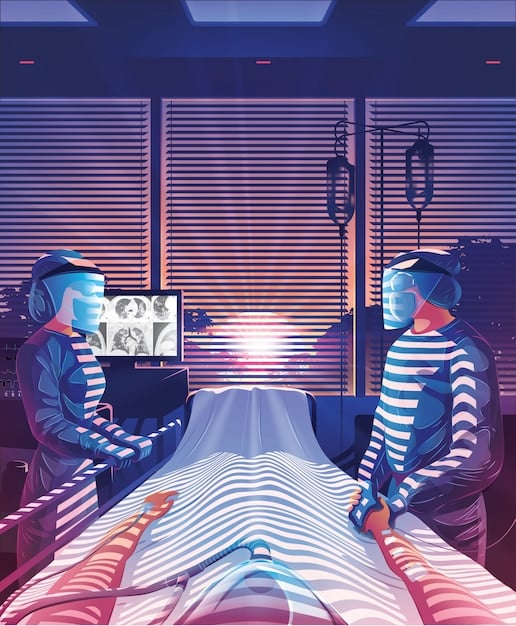US Researchers Discover New Antibiotic: Battling Resistance Effectively

A new antibiotic discovery by US researchers offers a promising avenue in the fight against escalating antibiotic resistance, potentially providing novel treatment options for previously untreatable bacterial infections and revolutionizing global public health efforts against superbugs.
The global health community faces an urgent and growing crisis: antibiotic resistance. As bacteria evolve, many of our most powerful drugs are losing their effectiveness, leaving us vulnerable to once-treatable infections. But what if a new discovery could shift this challenging paradigm? This article asks whether US Researchers Discover New Antibiotic: How Will This Help Combat Antibiotic Resistance?
Understanding the Antibiotic Resistance Crisis
The emergence of antibiotic resistance represents one of the most pressing public health challenges of our time. Bacteria, driven by evolutionary pressures and the widespread use of antibiotics, have developed sophisticated mechanisms to evade the very drugs designed to eliminate them. This phenomenon threatens to return medicine to a pre-antibiotic era, where common infections and minor injuries could once again become life-threatening. The implications are profound, affecting everything from routine surgeries to cancer chemotherapy, as the risk of untreatable infections skyrockets. Hospitals worldwide are already grappling with multi-drug resistant organisms, often dubbed “superbugs” that defy current treatments, leading to prolonged illnesses, increased mortality rates, and significant economic burdens on healthcare systems. This global threat necessitates urgent action, emphasizing the critical need for new therapeutic agents and improved antimicrobial stewardship.
The Mechanisms of Resistance
Bacteria employ various strategies to become resistant to antibiotics. These mechanisms can be innate or acquired through genetic mutations and horizontal gene transfer. Understanding these processes is crucial for developing new drugs that can circumvent these defenses.
- Efflux Pumps: Bacteria can pump the antibiotic out of their cells before it can reach its target concentration.
- Enzymatic Inactivation: Some bacteria produce enzymes that chemically modify or destroy the antibiotic.
- Target Modification: The bacterial target site of the antibiotic can be altered, reducing the drug’s binding affinity.
- Reduced Permeability: Changes in the bacterial cell wall or membrane can prevent the antibiotic from entering the cell effectively.
The widespread use and misuse of antibiotics in human medicine and agriculture significantly contribute to the acceleration of resistance. Every time an antibiotic is used, susceptible bacteria are eliminated, leaving resistant strains to proliferate. This selective pressure inadvertently favors the survival and spread of resistant microbes, underscoring why new discoveries are so vital; they offer a chance to break this cycle.
Breakthroughs by US Researchers: A New Hope?
Recent announcements regarding a new antibiotic discovered by US researchers have ignited considerable optimism within the scientific and medical communities. This discovery, stemming from innovative screening methods and a deeper understanding of microbial environments, marks a significant stride in the perpetual race against resistant pathogens. The details surrounding this compound, including its unique mechanism of action and preliminary efficacy data, suggest it could be a potent weapon against some of the most formidable superbugs currently plaguing healthcare systems. While still in early stages of development and subject to rigorous testing and regulatory approval, the potential impact of such a breakthrough can hardly be overstated. This is not just about adding another drug to the arsenal; it’s about pioneering a new class of antibiotics that bacteria may not have yet encountered, offering a temporary but critical advantage in infection control.
Initial reports indicate that this antibiotic targets bacterial processes previously untouched by conventional drugs, which is crucial for overcoming established resistance mechanisms. This novel approach minimizes the likelihood of pre-existing resistance and opens new avenues for therapeutic intervention. Researchers utilized advanced screening techniques, including AI-driven drug discovery platforms and high-throughput screening of environmental microbial samples, to identify this promising compound. The complexity of discovering new antibiotics often involves sifting through millions of potential molecules, making this targeted discovery particularly remarkable.
The enthusiasm surrounding this discovery is tempered by the understanding that a long and arduous path lies ahead before it could reach patient care. Nevertheless, the initial data are sufficiently compelling to warrant cautious optimism. This finding underscores the importance of sustained investment in basic research and drug discovery, especially in the often-overlooked area of antibiotics, which has seen dwindling private sector investment due to commercial challenges. It also reaffirms the United States’ position at the forefront of biomedical research, contributing substantially to global health security. The collaboration between academic institutions, government agencies, and potentially pharmaceutical companies will be key to moving this discovery from the lab to clinical application.
The Novel Mechanism of Action: Why It Matters
The efficacy of any new antibiotic hinges critically on its mechanism of action. In the context of escalating antibiotic resistance, a novel mechanism is not merely an advantage; it is a necessity. Many existing antibiotics share similar targets within bacterial cells, such as cell wall synthesis or protein production. Consequently, bacteria have evolved defenses against these common mechanisms, often developing cross-resistance to entire classes of drugs. The new antibiotic discovered by US researchers is reported to employ a previously unexploited pathway within bacterial physiology. This novel approach means that the resistance mechanisms bacteria have developed against current drugs are unlikely to be effective against this new compound, offering a significant strategic advantage. It forces bacteria to “start from scratch” in evolving resistance, buying invaluable time for patients and healthcare systems.
Targeting New Pathways
The new antibiotic reportedly targets a vital, yet unique, aspect of bacterial metabolism or structure that is essential for their survival but significantly different from human cell biology. This high specificity reduces the risk of off-target effects in patients while ensuring potent antibacterial activity.
* Uncharted Metabolic Pathways: Interruption of a unique bacterial metabolic process, like specific enzyme activities not present in human cells.
* Disruption of Virulence Factors: Targeting components essential for bacterial pathogenesis, such as toxin production or biofilm formation, rather than just growth.
* Novel Cell Division Interference: Disturbing unique bacterial cell division machinery, leading to non-viable bacterial cells.
This fresh approach contrasts sharply with the strategy of merely modifying existing antibiotics, which often leads to rapid re-emergence of resistance. By attacking a previously unassailed vulnerability, this new drug offers a genuine opportunity to overcome current resistance profiles. It represents a paradigm shift from incremental improvements to foundational innovation in the fight against superbugs.
Furthermore, a novel mechanism could also slow the development of resistance to the new drug itself. Since bacteria have not been exposed to a compound with this specific mode of action, they lack pre-existing adaptations. This buys more time before resistance inevitably emerges, enabling more effective treatment and better patient outcomes. The discovery emphasizes the importance of exploring diverse biological targets within bacteria, moving beyond the well-trodden paths that have characterized antibiotic development for decades.
Potential Applications and Clinical Impact
The discovery of a new antibiotic carries immense potential for transforming the landscape of infection treatment, particularly for multidrug-resistant (MDR) infections. The clinical impact could extend across various medical specialties, from critical care and oncology to transplant medicine and routine community infections. For years, clinicians have faced the disheartening reality of having limited or no effective treatments for certain “superbug” infections, leading to higher rates of morbidity and mortality. This new compound offers a glimmer of hope, potentially providing a much-needed lifeline for patients battling otherwise untreatable bacterial invaders. Its introduction could alleviate the pressure on existing antibiotics, allowing for more judicious use and thereby helping to preserve their effectiveness. Moreover, the availability of a new a new therapeutic option could significantly reduce the length of hospital stays, lower healthcare costs, and improve overall patient outcomes.
Key Areas of Impact
The anticipated applications of this new antibiotic span several critical domains within healthcare, addressing some of the most dire needs.
* Hospital-Acquired Infections: Many healthcare-associated infections are caused by resistant bacteria. This antibiotic could be crucial for treating ventilator-associated pneumonia, bloodstream infections, and surgical site infections.
* Community-Acquired MDR Infections: Infections like resistant urinary tract infections or skin infections often leave patients with limited oral treatment options. A new drug could provide effective outpatient care.
* Empiric Therapy: Clinicians often start treatment with broad-spectrum antibiotics empirically. A new drug with broad activity against resistant strains could improve initial treatment success rates.
* Global Health Security: By adding to the global antibiotic arsenal, this discovery strengthens preparedness against future pandemics driven by bacterial pathogens.

The current antibiotic pipeline is remarkably dry, with very few truly novel compounds reaching clinical trials. This new discovery therefore doesn’t just fill a gap; it creates new possibilities. It could allow for the re-evaluation of treatment protocols, potentially moving away from “last-resort” drugs that often have significant side effects, towards safer and more effective alternatives. The availability of this antibiotic might also encourage more targeted therapy, where specific resistant pathogens can be directly addressed, thereby reducing the risk of further resistance development. Furthermore, its existence could spur more investment and innovation in the stagnant field of antibiotic research, fostering a renewed sense of urgency and possibility among researchers and pharmaceutical companies. This development is not merely a scientific achievement; it’s a profound advancement for global public health infrastructure.
Challenges on the Road to Clinical Use
While the discovery of a new antibiotic by US researchers is undeniably exciting, the path from laboratory breakthrough to widespread clinical availability is fraught with significant challenges. The drug development process is notoriously long, arduous, and expensive, particularly for antibiotics. A new compound must navigate a series of rigorous preclinical and clinical trials to establish its safety, efficacy, and optimal dosing in humans. Many promising candidates fail at various stages due to unforeseen toxicity, lack of potency in complex biological systems, or production difficulties. Regulatory approval bodies, such as the Food and Drug Administration (FDA) in the US, impose stringent requirements, which are necessary to protect public health but further protract the development timeline. Beyond regulatory hurdles, there are substantial manufacturing and distribution challenges, ensuring that the drug can be produced at scale and reach the patients who need it most, particularly in resource-limited settings. The economic model for antibiotic development also presents a hurdle; historically, antibiotics have offered limited returns on investment compared to other drug classes, due to their relatively short course of treatment and the imperative for judicious use to preserve efficacy.
Key Hurdles
Several critical stages and obstacles define the journey of an antibiotic from discovery to clinical deployment:
* Phase 1 Trials: Focusing on safety and pharmacokinetics in a small group of healthy volunteers. Unacceptable side effects can halt development here.
* Phase 2 Trials: Assessing efficacy and optimal dosing in a larger group of patients with the target infection. The drug must demonstrate real-world effectiveness.
* Phase 3 Trials: Large-scale trials comparing the new drug against existing treatments, validating its benefits and identifying rarer side effects. This is the most expensive and time-consuming phase.
* Regulatory Approval: Submission of comprehensive data to regulatory authorities like the FDA, who conduct extensive reviews before granting approval.
* Manufacturing and Scale-up: Developing efficient and cost-effective methods for producing the drug in large quantities, ensuring quality control.
Another significant challenge will be to ensure responsible stewardship of this new antibiotic once it becomes available. If misused or overused, bacteria will inevitably develop resistance to it, just as they have to previous drugs. Strategies for thoughtful deployment, including restricted use protocols, diagnostic-driven therapy, and global surveillance, will be critical to sustain its effectiveness for as long as possible. The investment required is massive, not just in discovery, but in the entire ecosystem that supports the sustained utility of new antibiotics. This calls for concerted efforts from governments, pharmaceutical companies, academic institutions, and international organizations to create sustainable incentive models and robust public health policies.
The Future of Antibiotic Development and Resistance Management
The discovery by US researchers, while significant, highlights an underlying truth: the fight against antibiotic resistance is a continuous arms race. The future of antibiotic development must therefore move beyond episodic breakthroughs and embrace a more systemic, proactive approach. This involves diversification of research strategies, exploring not only new chemical entities with novel mechanisms of action but also alternative therapeutic modalities like phage therapy, antibody treatments, and adjunctive therapies that enhance the efficacy of existing drugs. Innovations in diagnostics are equally crucial, enabling rapid and accurate identification of pathogens and their resistance profiles, thereby guiding appropriate treatment decisions and reducing unnecessary antibiotic use. Furthermore, global collaboration and surveillance are paramount. Bacteria do not respect national borders, and resistance genes can spread rapidly across continents. An integrated international effort to monitor resistance trends, share data, and coordinate research and development activities is essential for preempting future crises.
Strategic Pillars for the Future
A multi-pronged strategy is necessary to effectively manage and mitigate the threat of antibiotic resistance:
* Investment in Basic Science: Funding foundational research to understand bacterial biology and resistance mechanisms better, identifying new targets.
* Innovative Drug Discovery: Utilizing artificial intelligence, machine learning, and high-throughput screening to accelerate the identification of new compounds.
* Alternative Therapies: Exploring non-antibiotic approaches such as vaccines, probiotics, microbiome modulation, and therapies that disarm bacteria without killing them.
* Antimicrobial Stewardship: Implementing programs that promote the appropriate use of antibiotics in human and animal health, preventing misuse and overuse.
* Global Surveillance and Data Sharing: Establishing robust international networks to track resistance trends and enable rapid public health responses.

Beyond scientific innovation, policy frameworks and economic incentives play a critical role. Governments and international bodies must create sustainable market conditions that encourage pharmaceutical companies to invest in antibiotic research and development despite the commercial challenges. This could include push incentives (grants, tax credits) and pull incentives (market entry rewards, transferable exclusivity vouchers) that decouple profitability from sales volume, aligning commercial interests with public health needs. Education for both healthcare providers and the public is also vital, fostering a collective understanding of antibiotic resistance and empowering individuals to contribute to responsible antibiotic use. The new antibiotic may buy us some time, but it is the comprehensive and sustained effort across science, policy, and public behavior that will truly determine our long-term success against this enduring threat. The goal is not just to find new drugs, but to secure a future where bacterial infections remain treatable for generations to come.
Public Health Implications and Global Impact
The discovery of a new antibiotic by US researchers carries profound public health implications that extend far beyond national borders. Antibiotic resistance is inherently a global crisis, requiring collective action. The successful development and responsible deployment of this new compound could offer a critical reprieve, bolstering global health security by providing an effective treatment option against pathogens that currently defy therapeutic intervention. This can prevent countless deaths, reduce the burden on healthcare systems worldwide, and safeguard modern medical practices that rely on the availability of effective antibiotics, such as surgeries, organ transplants, and cancer treatments. Moreover, it symbolizes a renewed hope and injects momentum into the often-discouraging field of antibiotic research, potentially inspiring further investment and innovation globally. The very existence of this new drug could catalyze a paradigm shift in how international bodies and national governments prioritize funding and policy for antimicrobial resistance (AMR), recognizing the interconnectedness of human, animal, and environmental health in this challenge.
The global impact will be multifaceted:
* Reduced Mortality and Morbidity: With a new effective treatment, the rates of severe illness and death from resistant infections are expected to decline.
* Healthcare System Resilience: Hospitals and clinics will be better equipped to handle outbreaks of resistant bacteria, reducing facility closures and overwhelmed ICUs.
* Economic Savings: Fewer prolonged hospital stays, reduced need for expensive last-resort drugs, and a healthier workforce contribute to significant economic benefits worldwide.
* Strengthened Research Collaboration: The success could foster more international partnerships in drug discovery, surveillance, and policy formulation.
* Boost to Medical Tourism and Global Travel: By reducing the risk of resistant infections, the new antibiotic can indirectly contribute to safer global travel and interactions.
However, the global implications also underscore the ethical imperative for equitable access. Ensuring that this new antibiotic benefits all populations, regardless of economic status, will be a critical challenge requiring international cooperation and innovative financing mechanisms. Preventing misuse and ensuring proper stewardship on a global scale will demand robust international agreements and educational campaigns. Ultimately, the new antibiotic serves as a powerful reminder that while science can provide the tools, collective human action—through responsible use, equitable distribution, and sustained investment—is essential to win the global battle against antibiotic resistance. It’s a beacon of hope, but one that demands ongoing vigilance and collaboration to realize its full potential for global public health.
| Key Point | Brief Description |
|---|---|
| 🔬 Novel Discovery | US researchers found a new antibiotic with a unique mechanism of action against resistant bacteria. |
| 🛡️ Combating Resistance | Its novel mechanism targets pathways unchecked by current drugs, offering hope against superbugs. |
| 🚧 Development Hurdles | Long, costly clinical trials and regulatory approval process before widespread clinical use. |
| 🌍 Global Impact | A potential breakthrough for global public health, improving outcomes for intractable infections. |
Frequently Asked Questions
▼
Antibiotic resistance occurs when bacteria develop the ability to defeat the drugs designed to kill them. This makes infections harder, and sometimes impossible, to treat. It leads to longer hospital stays, higher medical costs, and increased deaths globally, posing a major threat to public health.
▼
A novel mechanism means the new antibiotic attacks bacteria in a way not seen in existing drugs. This is crucial because bacteria haven’t yet evolved defenses against this new attack method, offering a vital advantage against current superbugs and slowing the development of new resistance.
▼
While the initial discovery has been announced, the antibiotic is still in early stages of development. It will need to undergo rigorous preclinical and multi-phase clinical trials to prove its safety, efficacy, and optimal dosage before it can be approved for widespread human use, a process that can take many years.
▼
Discovering new antibiotics is challenging due to several factors: the complexity of bacterial biology, the high cost and long duration of drug development, and the low financial returns compared to other drug classes. Most promising candidates fail during development, making breakthroughs rare and valuable.
▼
This discovery offers significant hope for global public health. It could provide effective treatment for previously untreatable infections, reduce patient mortality and morbidity, ease the burden on healthcare systems, and foster renewed investment and innovation in the stagnant field of antibiotic research worldwide.
Conclusion
The recent discovery of a new antibiotic by US researchers represents a critical and timely beacon of hope in the ongoing battle against antibiotic resistance. This breakthrough, driven by innovative research and a deeper understanding of microbial vulnerabilities, holds the promise of revitalizing our therapeutic arsenal against increasingly formidable superbugs. While the journey from laboratory to widespread clinical use is undeniably long and complex, filled with rigorous testing and regulatory hurdles, the potential impact of such a novel compound is immense. It underscores the vital importance of sustained investment in scientific inquiry, international collaboration, and diligent antimicrobial stewardship. Ultimately, this discovery is not merely a scientific achievement; it is a profound testament to human ingenuity and a crucial step towards securing a future where treatable infections remain just that: treatable, for generations to come.





